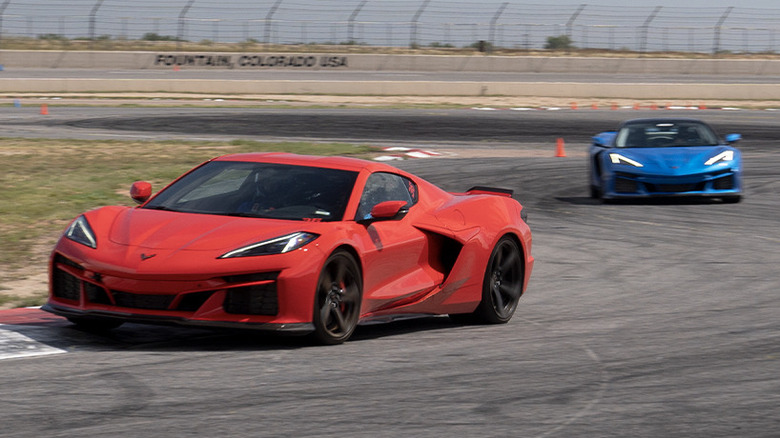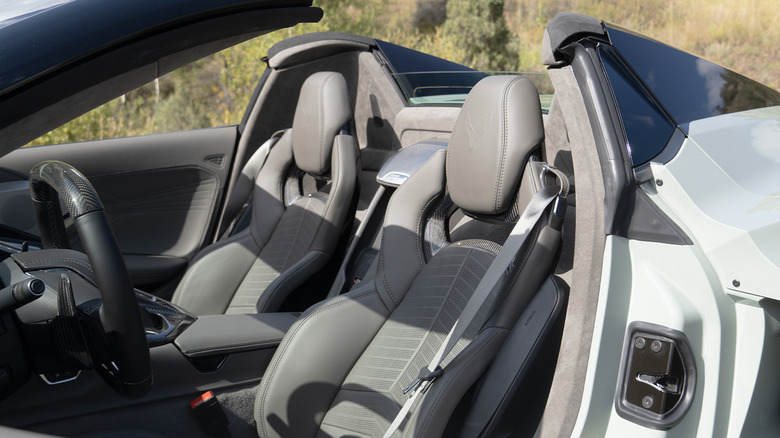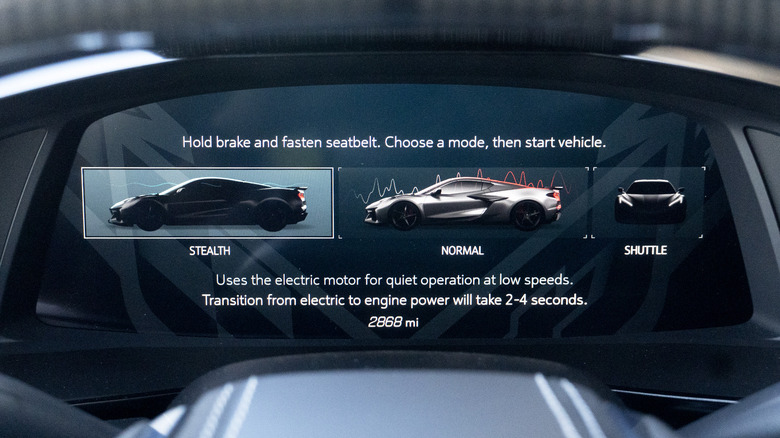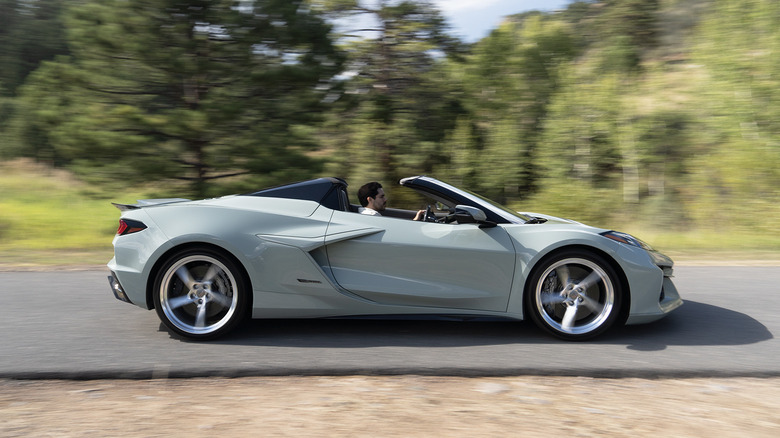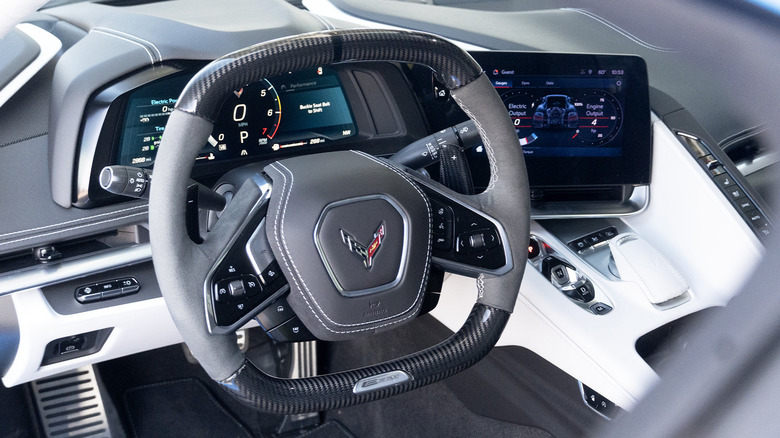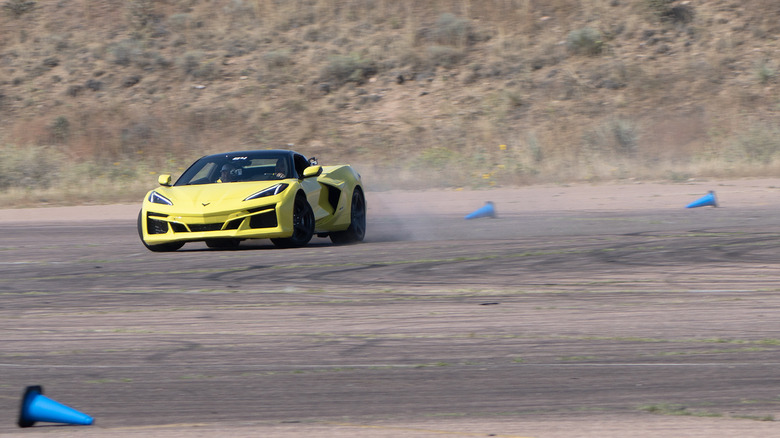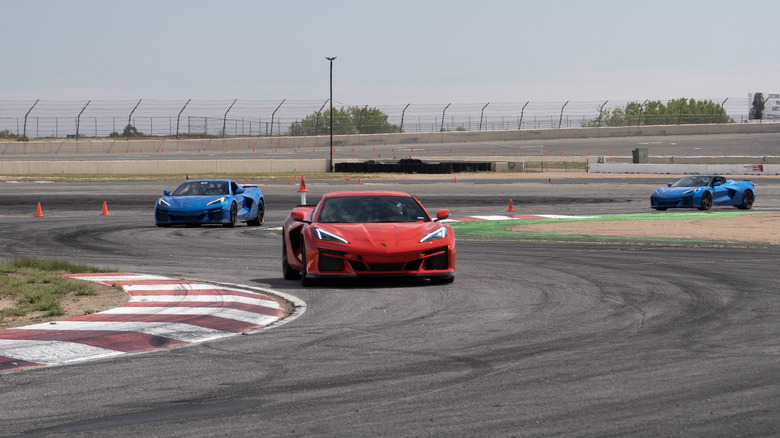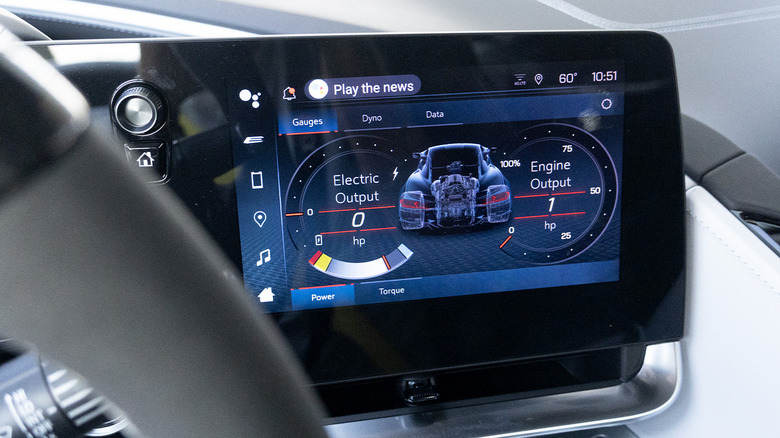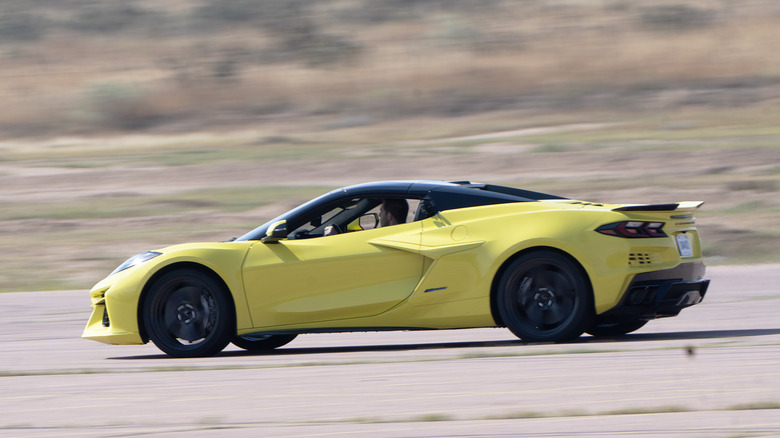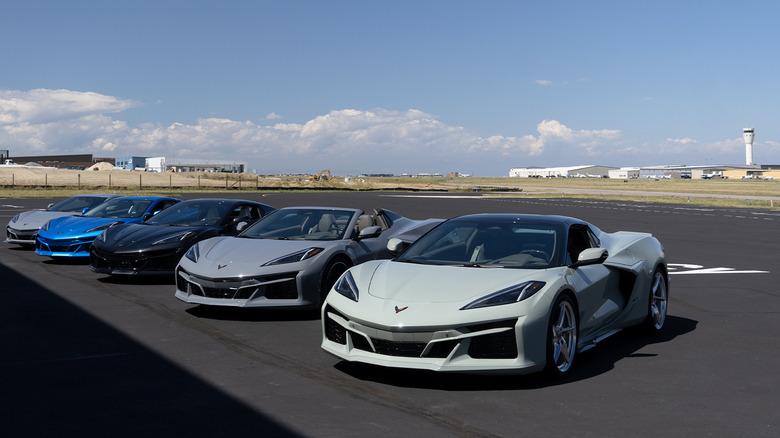2024 Chevrolet Corvette E-Ray First Drive: Z06-Beating Hybrid Offers More Than Just Speed
As a way of introducing the new 2024 Corvette E-Ray, Executive Chief Engineer of Corvette Tadge Juechter starts his presentation by describing Chevy's new hybrid, all-wheel-drive supercar as "The most complicated consumer product you can buy." And the new hybrid drivetrain doesn't disappoint on paper, proudly establishing a new standard as the quickest Corvette ever built, with an LT2 V8 powering the rear wheels complemented by an electric motor adding a bit more grunt up front.
Juechter's somewhat hyperbolic statement, which he claims covers everything from iPhones to private jets, might just be accurate. I'd argue that a Porsche Cayenne Turbo E-Hybrid with a twin-turbocharged V8, all-wheel drive, air suspension, and rear-wheel steering takes the cake. Or a perennially misunderstood Acura NSX, with its three electric motors connected through a complex drivetrain to a twin-turbo V6. But after some deliberation, I can concede that the E-Ray might just win out because it also offers a retractable hardtop and standard carbon-ceramic brakes.
Fun features of a hybrid Corvette
I'm not a convertible fan, in general, but the first E-Ray I hop into hoping to nab the new Cacti Green paint job does lay the rooftop back for open-air cruising. But more importantly, first things first: Time to try out the nifty new "Stealth" and "Shuttle" modes made possible by the fully electric front motors. Similar to Crab Walk on a Hummer EV, Stealth and Shuttle can easily seem like a gimmick, but both actually provide much more reasonable use cases than slinging a 9,000-pound electric SUV around semi-sideways.
Essentially, the E-Ray can drive in similar fashion as a more conventional plug-in hybrid, silently at first in the hopes of potentially keeping neighbors happy. But the Corvette lineage prompted Juechter's team to prioritize power delivery, both into and out of the battery pack, rather than additional capacity to maximize all-electric range. So the E-Ray only ever uses about 1.1 kilowatt-hours out of a total capacity of 1.9 kilowatt-hours, to help keep the temperature of the 80 cell pouches within the ideal operating range that allows Chevy to offer an eight-year, 100,000-mile warranty on the electric components.
Stealth and Shuttle modes in action
Stealth mode gives owners the opportunity to drive silently, hopefully avoiding spats with neighbors by not firing up the V8 first thing in the morning, though that usable kilowatt-hour figure means the battery will only last for about three to five miles. Tip far enough into the gas pedal or run the battery low enough and the engine wakes up with a sharp bark. Shuttle mode, on the other hand, limits top speed to only 15 miles an hour but will never prompt ignition until the driver selects a new drive mode via the C8's entirely un-ergonomic drive mode selector wheel.
Both systems work well, I learn on a quick jaunt around the airstrip where Chevy handed off our first batch of E-Rays before a road drive. And both seem infinitely more useful than the Hummer EV's crab walking skills, which I could never figure out how to use in reverse while parallel parking. But using either Stealth or Shuttle modes also brings up the main sacrifice that Juechter's team of engineers made while developing the E-Ray: Even with that minimal capacity, the battery pack and management system in the C8's massive center tunnel adds 160 pounds, contributing to a total curb weight that escalates to as high as 4,056 pounds for the hardtop convertible variant.
Out of the airport and into the streets
Out on public roads, the C8's sublime mid-engine chassis effectively masks most of that significant bulk-up, a gain that measures about 20% more than a base Stingray's sveltest possible spec of 3,366 pounds. Selecting the softest setting for my car's magnetic ride suspension perfectly complemented the open-topped sunshine—not to mention ventilated seats, a godsend in the Colorado sun—keeping me in sheer comfort for most of the day. Only the worst freeway surfaces on the way out of Denver and into the Rockies created enough tire hum to overcome the reverie.
Then, once onto the windy roads that supercars call home, the E-Ray's record as quickest Corvette ever came into play. The claimed 0-60 time of 2.5 seconds seems eminently possible, if not quite on the (also record-setting) Michelin Pilot Sport All-Season tires this car came equipped with from the factory. Keep that pedal to the metal and the system unloads power from both the roaring V8 and the electric motor, the latter of which does produce a minor amount of pleasurable (for me, personally) electric whine at full gallop.
Tighter roads require tighter modes
Then I firmed up the suspension by selecting the Z drive mode, which also tightens up the electric power steering noticeably, sharpens throttle response, and opens up the exhaust. But as I've found only on a few other full EVs that send power to the front wheels, I actually preferred slightly more steering assist to lighten the perceived weight in my hand, due to the all-wheel-drive system's noticeable torque steer while mashing hard through corners.
With the right modes dialed and the canyons tightening in, I nevertheless started to find a flow, harnessing the all-wheel-drive system's low-end grip to haul out of corners and then banging up to the LT2's relatively low 6,500-RPM redline so frequently that I even stopped using the paddle shifters. Talk about peppy, with inspired confidence at both average pace and well into more aggressive carving.
Complex programming required for the separate AWD system
The E-Ray's electric motor sits beneath the front trunk, while the V8 slots in between the cockpit and the rear axle—never the twain do the drivetrains meet. During real-world driving, this layout means that Juechter's team needed to nail the ECU programming for throttle response and regenerative braking just right. On public roads, the system mostly worked as expected, other than when I lifted off a few times while trail braking into a turn, and the sudden front-end drag of regen snapped the steering wheel back towards the centerline with some significant force. The sensation surprised me, not quite the same as throttle liftoff oversteer but absolutely enough to ruin a perfect apex line. Curiouser and curiouser... How might this quirk of a hybrid supercar translate to the rest of the media program's autocross and track time, I started to wonder.
On a gritty parking lot behind the grandstands of Pikes Peak International Raceway, we as a collective found out. This time around, Chevy dropped media drivers into a fleet of E-Rays shod in the optional Michelin Pilot Sport 4S tires, as befitting the more aggressive series of exercises ahead. First, I loped through an autocross circuit littered with cones for a sighting lap of the tight turns, highlighted by a center ring intended for donut practice. Then I lined up for a first real rip around the course, immediately regretting the mistaken decision to left-foot brake with those carbon-ceramics, which led to plenty of skittering as the chompers hauled down speed much harder than expected after my time on the all-seasons.
Unintentional drift mode activated
Trying to make up time against the imaginary clock in my head, I pushed the E-Ray through a few tighter rotations too aggressively and found a bit of countersteer necessary even before entering the donut ring. And yet, while trying to set the car into a controlled slide, even fiddling with various traction control and electronic stability control settings, the E-Ray's 42:58 front-to-rear weight distribution, all-wheel traction, and occasionally unpredictable power delivery as the electric motor kicked in and feathered out left me struggling to master a perfect burnout. Then, after a spin or two (or three), the front axle simply turned off and left me in rear-drive only—suddenly I found myself feasting on a full box of donuts, no problemo.
I realized later that Chevy missed a huge opportunity to program the E-Ray with a dedicated drift mode that shuts down the front electric motor entirely (something similar to the RWD mode that the BMW M5 sedan has offered since 2018). After all, keeping the EV and ICE powertrains entirely separate allowed for fully electric Stealth and Shuttle modes, so why not vice versa? (And another interesting comparison comes from Germany: Mercedes-AMG's S 63 E-Performance that can send power rearward from a front electric motor through the center mechanical driveshaft, effectively retaining all-wheel drive while in full EV mode much more similarly to a real PHEV.)
Charge+ for repeated lapping
If any of the E-Ray's clever buttons and modes proved most impressive, though, stepping out onto PPIR's so-called "Roval" track gave Charge+ some time in the spotlight. By pressing the small Charge+ button to the right of the driver's knee on the massive center console, the E-Ray knows to prioritize power delivery out of corners, then dial back electric assist on straightaways in the name of conserving energy while keeping the battery pack and front motor within ideal operating temps.
For the first few laps, Chevy's lead-follow driver prompted us to keep Charge+ activated. And the battery gauge to the left side of the E-Ray's configurable center cluster showed how much charge flowed in and out during hard pulls and deceleration. But when the time came to go full-gas, with full output on tap at all times, the pace ratcheted up more than a few more notches. My braking points eased further back from corners, as the PS4S tires started to noticeably overheat and the battery quickly began to draw down.
Rally racing a mid-engine supercar
As a plus, that regen liftoff steering sensation all but vanished during hard track driving, since I started punching into the carbon ceramics well before cranking into steering input. Then, while navigating through a series of bends on the roval's infield, I found the fun factor that all-wheel-drive sports cars should always deliver, overloading the outside tire edge until the tires start to chatter and then squeal in protest, then matting the go pedal instead of backing off, not so much countersteering as trusting the fronts to pull out of oversteer with minimal tire angle required, trusting my hind legs to catch up after another moment or two of almost sliding sideways.
This kind of driving will shred just about any rubber and the E-Ray's additional heft obviously overwhelmed the PS4S tires, leading to more than a few delaminated bands available for our inspection in the pits. Maybe time to step up to the Cup 2 or Cup 2 R tires that come on the Z06 trim or Z07 package. On the other hand, the sheer silliness of finding the E-Ray's full abilities while cornering in borderline rally racing style might, just maybe, outweigh the cost of regular tire purchases, even if the performative dance never manages to reach the more predictable level of push-pull tendencies that AWD cars with front and rear axles connected via, you know, physical driveshafts rather than computer programming can deliver.
Another C8 variant in a class of its own
Rally racing a mid-engine supercar? Yes, I'm thinking about the Lamborghini Huracán Sterrato—and so should you, because Chevrolet should definitely "safari" the E-Ray with a lift for the mag ride suspension and a set of knobby all-terrain tires. But in the meantime, I found myself struggling to imagine the track rat who might take the stupendous, stupefying Z06 and an E-Ray out on back-to-back test drives and end up purchasing the all-wheel-drive hybrid over a flat-plane crank LT6 with an 8,500-RPM redline (at around the same price point). That's probably the reason that Chevy will emphasize the E-Ray's all-weather, all-season, all-wheel-drive capabilities in marketing materials. The C8 already brought in tons of new Corvette customers, after all, so why not pivot Corvette to a new paradigm of daily driveability?
Wrapping up my time in the E-Ray, I reflected back on the whole experience. In a sense, the new hybrid mid-engine drivetrain comes across as something of an interesting, perhaps inevitable, engineering exercise in the modern era. But comparing this Corvette to other super and hypercars ends up being an exercise in futility—we're not at the level of a LaFerrari, 918 Spyder, McLaren P1, or even NSX. All of which cost double, triple, or 10 times as much as an E-Ray, to be fair, but cut weight significantly with each additional dollar spent.
Tacking on the E-Ray's optional Performance Package adds a bit more aero, in the form of a front splitter, side rockers, and rear wickers that total up to 360 pounds of downforce. And eventually, Chevrolet will almost certainly add a range-topping twin-turbo hybrid to the Corvette lineup, likely named the Zora after engineer Zora Arkus-Duntov. Imagine a boosted LT6 spooling up to infinity and beyond with 1,000-plus horsepower and Z07 track goodies—all of a sudden, those 4,000-plus pounds of intricate engine and electrical components sound a bit more reasonable. But for now, at least until Porsche hybridizes the 911, once again a new C8 Corvette variant essentially occupies a class entirely of its own.
